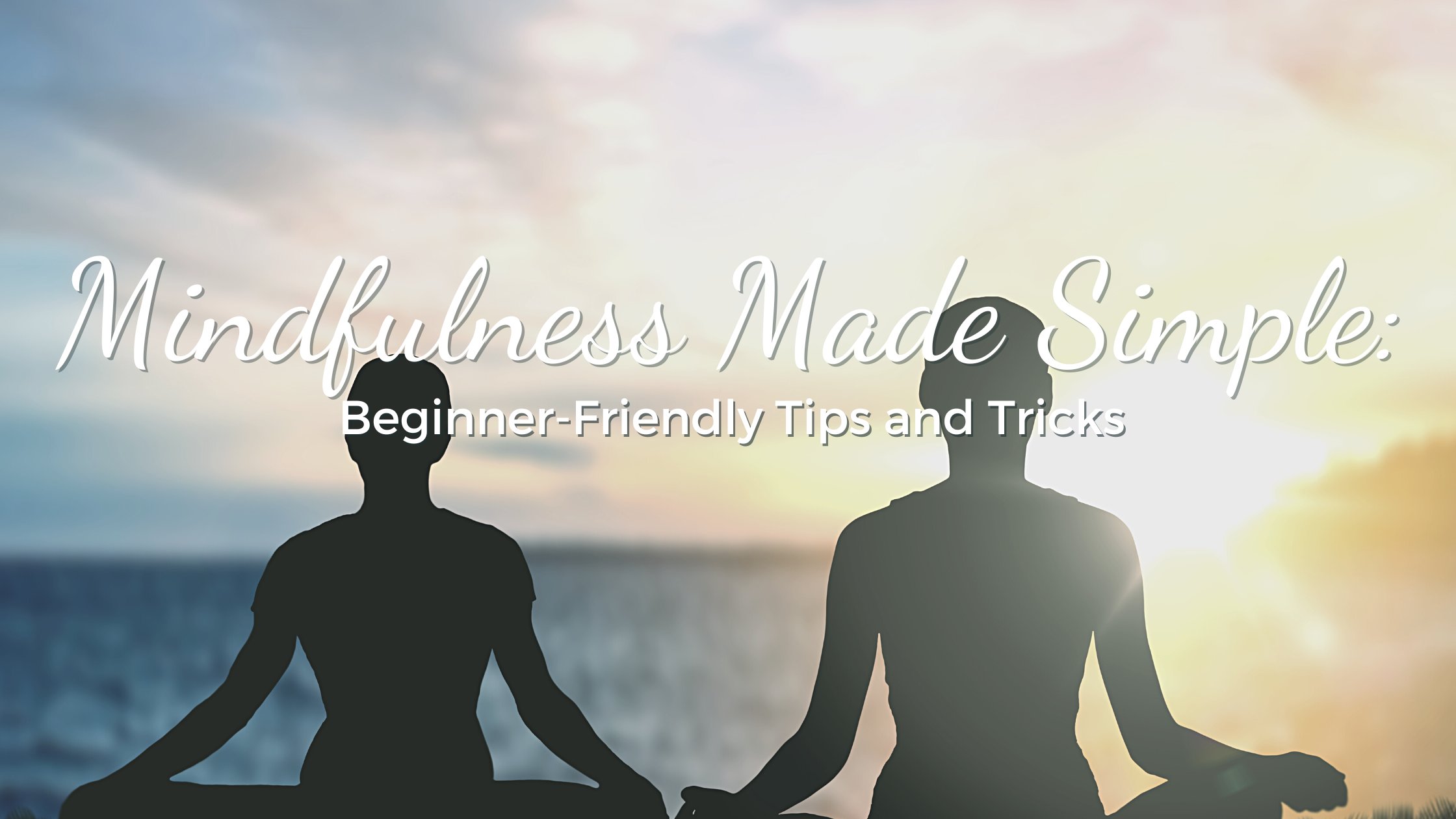Mindfulness Made Simple: Beginner-Friendly Tips and Tricks
Unlocking Tranquility: Mindfulness Made Simple
In a busy life, finding moments of peace and clarity can feel like an elusive dream. But what if I told you that the path to serenity could be simpler than you think? Welcome to a journey of self-discovery and inner calm as we delve into the art of mindfulness.
In this guide, we're about to embark on a profound exploration of "Mindfulness Made Simple." Whether you're a newcomer to the world of mindfulness or seeking to refresh your practice, you're in the right place. Together, we'll unravel the transformative power of mindfulness, one step at a time.
Imagine a life where every breath you take becomes a moment of solace, every meal a celebration of flavours, and even mundane activities like walking or showering become opportunities for profound presence. This guide is not just a roadmap; it's your passport to a mindful living adventure.
Here's What Awaits You:
🌬️ **Mindful Breathing Techniques:** We'll kick things off by exploring the essence of mindfulness through the art of conscious breathing. Discover how a few simple breaths can anchor you in the present moment.
🍽️ **Mindful Eating for Beginners:** We'll delve into the world of mindful eating, where your daily meals transform into rituals of nourishment and appreciation.
🏃 **Mindfulness in Daily Activities:** Learn how to infuse mindfulness into your everyday routines, turning mundane moments into opportunities for profound awareness.
🌿 **Creating a Mindful Space:** Your environment plays a crucial role in your mindfulness journey. We'll guide you on crafting a serene space that nurtures your inner tranquillity.
🌟 **Mindful Living Benefits:** Discover the myriad ways in which mindful living can elevate your well-being, from reducing stress to enhancing creativity.
Are you ready to embark on this journey toward a calmer, more centred you? It's time to embrace mindfulness, not as an unreachable ideal, but as a practical and accessible way of life. Let's begin our exploration of "Mindfulness Made Simple," and unlock the serenity that's been within you all along.
Mindful Breathing Techniques:
Mindful breathing is the foundation of mindfulness practice, and understanding its importance is the first step toward a more peaceful existence. When we focus on our breath, we tether ourselves to the present moment, gently steering our minds away from worries about the past or future. It's a gentle reminder that the here and now is where life unfolds. In the section on Basic Breath Awareness, we'll introduce you to the simplest of mindful breathing techniques. You don't need any special equipment or experience; just find a quiet spot, sit comfortably, and bring your attention to your breath. Observe its natural rhythm, the rise and fall of your chest or abdomen. It's a return to the elemental essence of being.
Basic Breath Awareness:
In our fast-paced lives, the idea of simplicity is often overlooked. Yet, mindfulness can be as basic as paying attention to your breath. Begin your journey by finding a peaceful moment and a comfortable place to sit or lie down. Close your eyes, if you wish, and simply breathe. Observe the inhale and exhale, the coolness as you breathe in, and the warmth as you breathe out. This fundamental practice is where mindfulness takes root. It invites you to be present with your breath, quieting the mental chatter and connecting you to the stillness within.
Counting Breath:
For those new to mindfulness, counting breaths is an accessible technique that provides structure to your practice. Inhale slowly to a count of four, and then exhale, matching that count. This rhythmic breathing not only keeps your focus anchored to the breath but also aids in relaxation. The simplicity of counting helps create a peaceful, meditative state. As you count each breath cycle, you'll notice your mind becoming more tranquil, and the worries of the day gradually fading into the background.
Box Breathing:
Box breathing is a valuable technique for reducing stress and enhancing mindfulness. It involves inhaling for a count of four, holding the breath for four, exhaling for four, and then pausing for four before beginning again. This method offers a structured approach to mindfulness and can be particularly useful in high-stress situations. By regulating your breath in this way, you bring balance and calmness to both body and mind. It's like hitting the reset button, allowing you to face challenges with greater clarity.
Mindful Eating for Beginners:
Mindful eating is a gateway to a more fulfilling relationship with food and a heightened appreciation for the act of nourishment itself. We start by highlighting the importance of this practice, showcasing how it can transform ordinary meals into extraordinary experiences. By embracing Eating with Awareness, readers will learn how to approach their meals with a sense of presence, savouring each bite and fully engaging their senses – from the taste and texture of the food to the inviting aroma.
But mindful eating is not just about the food; it's about the atmosphere you create. Consider crafting meaningful rituals around meals. This might include setting the table with care, expressing gratitude for the nourishment, or simply disconnecting from screens and distractions. These rituals elevate the act of eating to a moment of mindful reverence.
Moreover, we delve into the art of Listening to Hunger Cues. In a world of constant food availability, it's easy to lose touch with our body's signals. We encourage readers to tune in to their bodies, to eat when hungry, and to stop when satisfied. This practice not only promotes healthier eating habits but also fosters a deeper connection to the body's wisdom.
Finally, we extend an invitation to our readers through the Mindful Eating Challenge. It's an opportunity to put all these principles into action, perhaps starting with one meal a day where they apply the mindfulness techniques we've discussed. It's a transformative journey that begins at the dining table but can lead to a profound shift in one's relationship with food and well-being.
Mindfulness in Daily Activities:
In the hustle and bustle of our lives, it's easy to overlook the potential for mindfulness in the simplest of daily activities. Whether it's your morning shower, a quiet moment in the garden, or even washing dishes, these can all become opportunities for mindfulness. We encourage you to slow down, engage your senses, and be fully present during these activities. It's a powerful way to infuse your day with mindfulness.
Why not try and practice a Walking Meditation? This practice transforms each step into a mindful act. Imagine walking with a heightened awareness of each foot lifting, moving through the air, and making contact with the ground. You could practice this in a park, a quiet neighbourhood, or even within the confines of your own garden. Walking meditation can be a moving meditation, grounding you in the present moment.
For those dealing with daily commutes, why not try to make this a more mindful process? Whether you're travelling by car, bus, or train you can turn what is often a stressful part of the day into an opportunity for relaxation and presence. It's a way to arrive at your destination feeling more centred and less frazzled.
Lastly, you can consider the power of rituals within daily routines. Creating mindfulness rituals, such as a morning gratitude practice or an evening reflection, can provide structure and meaning to your day. These rituals become touchpoints for mindfulness, helping you start and end your day with intention and mindfulness. They are like gentle reminders to stay connected to the present moment amidst the chaos of daily life.
Creating a Mindful Space
The environment we inhabit plays a profound role in shaping our mindfulness journey. The Influence of the Environment is an essential consideration as it can either support or hinder your practice. A cluttered and chaotic space can be distracting, making it challenging to focus your mind. In contrast, a tidy and serene environment can foster tranquillity and make it easier to be present. The physical space you create can significantly impact the quality of your mindfulness practice.
To aid in cultivating a mindful environment, you could consider decluttering mindfully. It's not just about tidying up but also about letting go of possessions that no longer serve a purpose or hold sentimental value, try to create a space that is intentionally curated and free from unnecessary distractions.
I encourage you to infuse your surroundings with elements that promote mindfulness. This could include selecting calming colours for your decor, incorporating natural elements like plants to connect with the outdoors, or displaying soothing artwork that inspires serenity. Personalisation helps make your space uniquely yours and enhances its capacity to nurture mindfulness.
Why not create a meditation nook? Having a designated space for meditation or mindfulness practice carries numerous benefits. It offers a dedicated sanctuary where you can retreat from the outside world and find solace. Even in small living spaces, there are creative ways to carve out a meditation nook. Set up this sacred space, ensuring that you have a tranquil refuge to return to whenever you need a moment of mindfulness in your day.
Mindful Living Benefits
Mindfulness is not just a fleeting trend; it's a transformative practice with a plethora of benefits that touch every aspect of our lives. There are myriad advantages of incorporating mindfulness into your daily routine. From enhancing mental health and reducing stress to sharpening focus, boosting creativity, and fostering healthier relationships, the positive impacts are both broad and profound.
Mindful living offers a multitude of profound benefits that enhance every facet of our lives. First and foremost, it promotes mental well-being by reducing stress and anxiety, fostering a calmer and more centred mind. It sharpens our focus and cognitive abilities, enabling us to navigate life's challenges with greater clarity. Mindfulness also sparks creativity, helping us see the world with fresh eyes and fostering innovative thinking. In our relationships, it promotes empathy and effective communication, deepening our connections with others. Overall, mindful living is a holistic approach to well-being that not only improves our mental and emotional health but also enriches our daily experiences, leading to a more fulfilled and purposeful life.
"Mindfulness Made Simple: Beginner-Friendly Tips and Tricks" unveils the transformative power of mindfulness, offering practical insights into its practice and numerous benefits. From mindful breathing to savouring meals, integrating mindfulness into daily tasks, and creating a serene environment, these practices can enrich your life in countless ways. By embracing mindfulness, you embark on a journey of self-discovery, mental clarity, enhanced creativity, and deeper connections with others. Remember, this path is accessible to everyone, and its rewards are both attainable and enduring. As you take those initial steps toward mindful living, may you discover a world of tranquillity, resilience, and overall well-being waiting to unfold within you.





